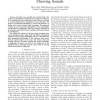9 search results - page 1 / 2 » Automatic detection of trends in time-stamped sequences: an ... |
SOCO
2010
Springer
13 years 2 months ago
2010
Springer
This paper presents an evolutionary algorithm for modeling the arrival dates in time-stamped data sequences such as newscasts, e-mails, IRC conversations, scientific journal artic...
BIBM
2007
IEEE
13 years 8 months ago
2007
IEEE
Chewing is an essential part of food intake. The analysis and detection of food patterns is an important component of an automatic dietary monitoring system. However chewing is a t...
BMCBI
2007
13 years 4 months ago
2007
Background: Protein remote homology detection is a central problem in computational biology. Most recent methods train support vector machines to discriminate between related and ...
EVOW
2001
Springer
13 years 9 months ago
2001
Springer
The integrated circuits design flow is rapidly moving towards higher description levels. However, test-related activities are lacking behind this trend, mainly since effective faul...
BMCBI
2004
13 years 4 months ago
2004
Background: Multiple sequence alignment algorithms are very important tools in molecular biology today. Accurate alignment of proteins is central to several areas such as homology...

